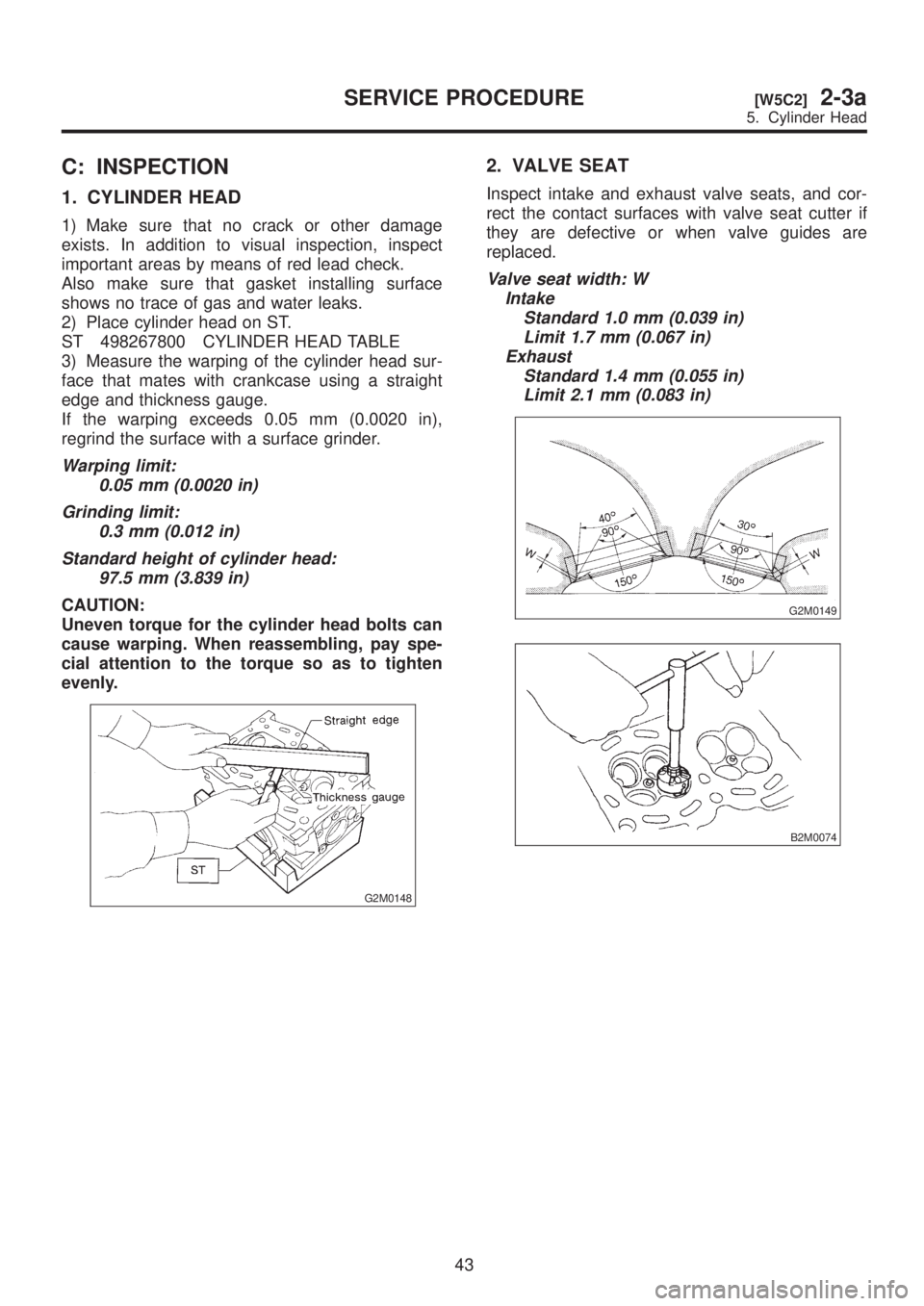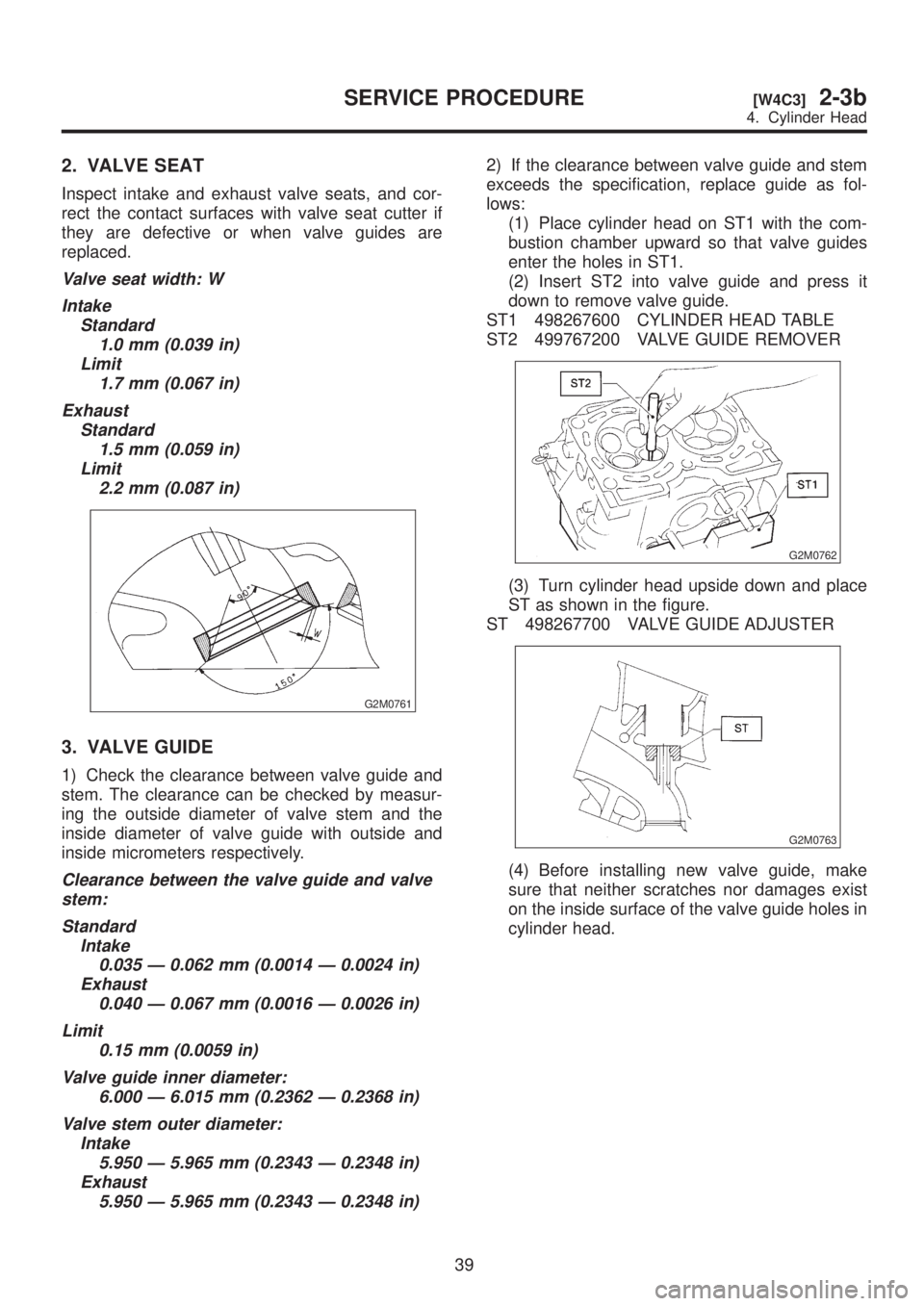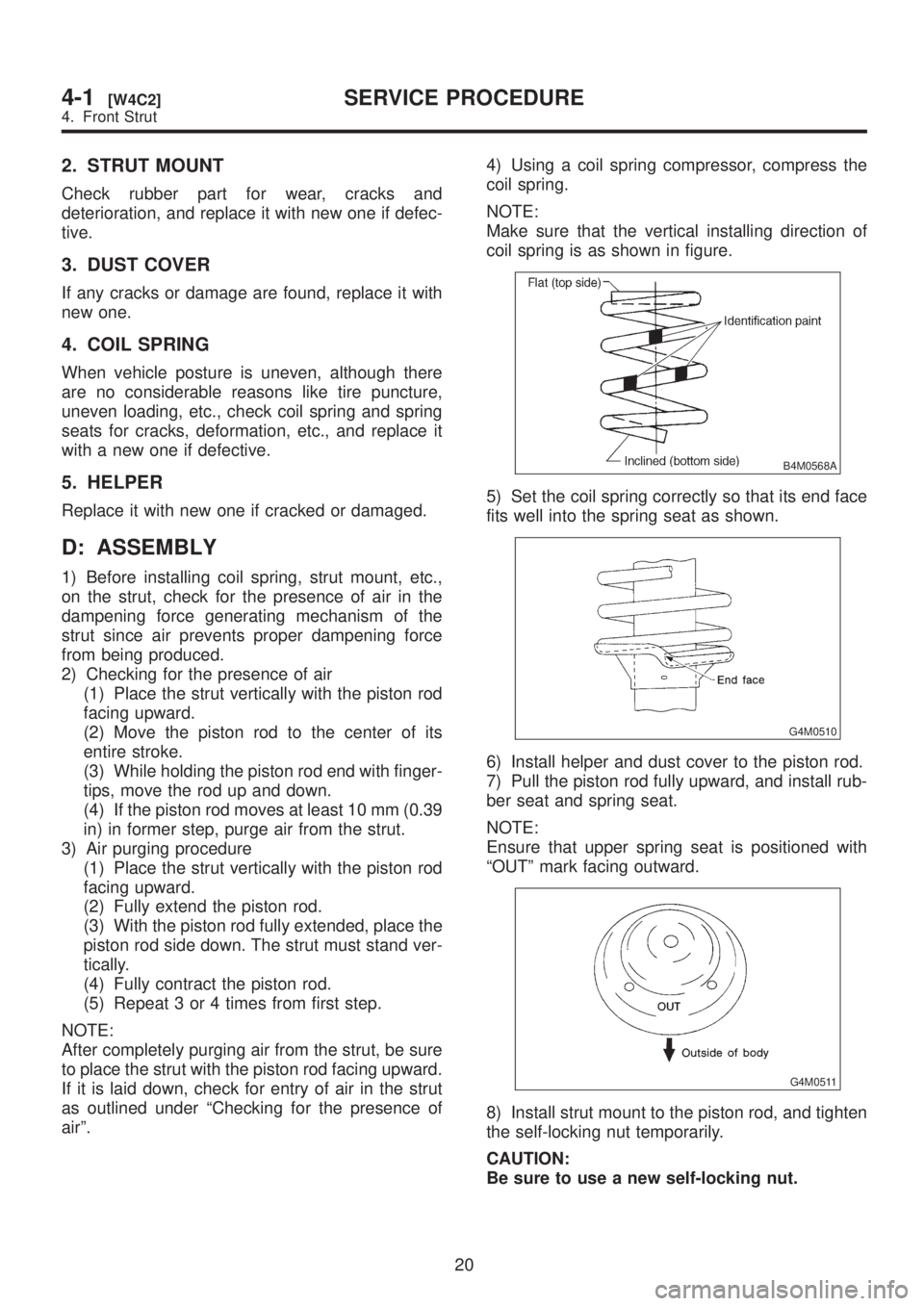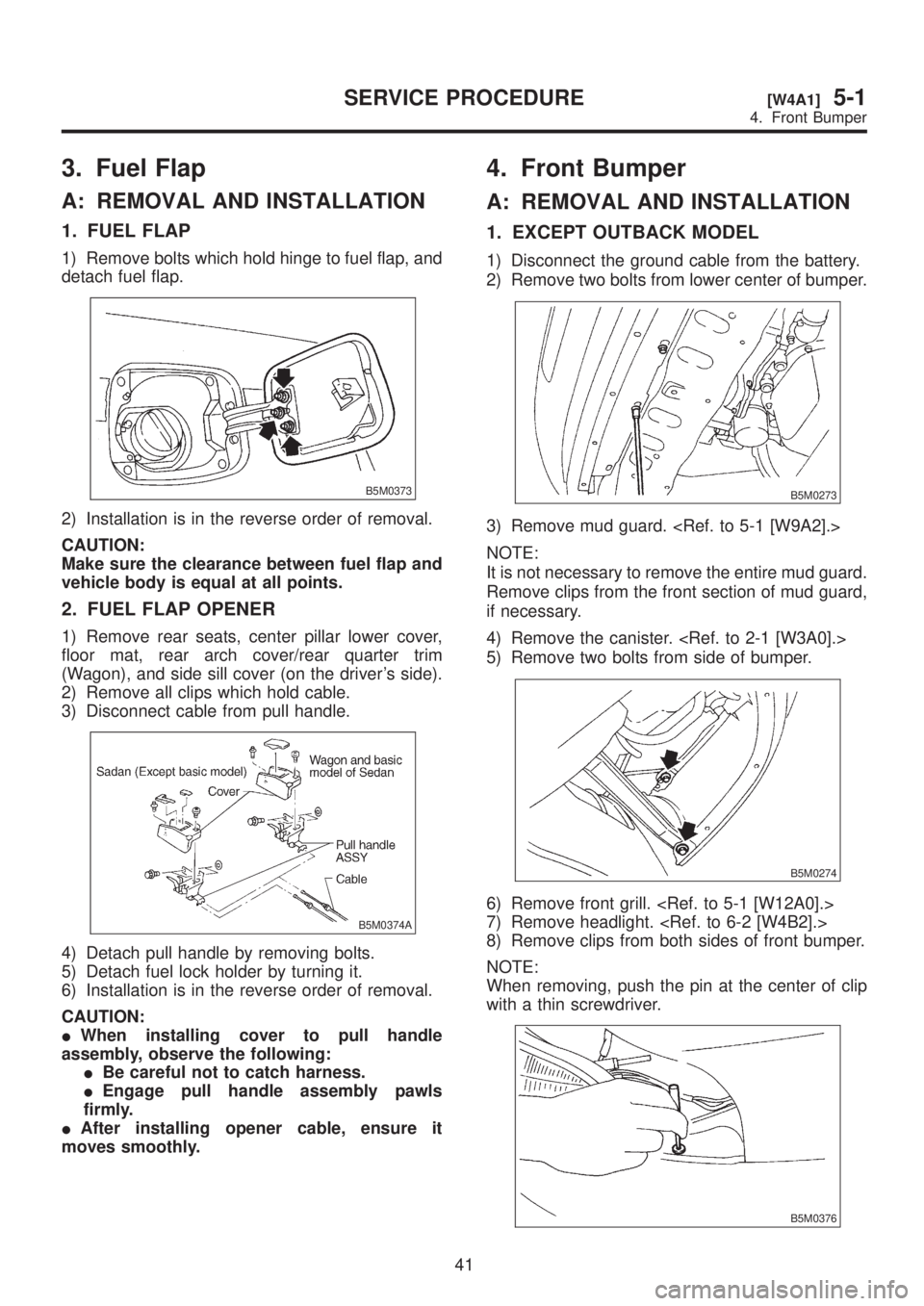1999 SUBARU LEGACY seats
[x] Cancel search: seatsPage 97 of 1456

C: INSPECTION
1. CYLINDER HEAD
1) Make sure that no crack or other damage
exists. In addition to visual inspection, inspect
important areas by means of red lead check.
Also make sure that gasket installing surface
shows no trace of gas and water leaks.
2) Place cylinder head on ST.
ST 498267800 CYLINDER HEAD TABLE
3) Measure the warping of the cylinder head sur-
face that mates with crankcase using a straight
edge and thickness gauge.
If the warping exceeds 0.05 mm (0.0020 in),
regrind the surface with a surface grinder.
Warping limit:
0.05 mm (0.0020 in)
Grinding limit:
0.3 mm (0.012 in)
Standard height of cylinder head:
97.5 mm (3.839 in)
CAUTION:
Uneven torque for the cylinder head bolts can
cause warping. When reassembling, pay spe-
cial attention to the torque so as to tighten
evenly.
G2M0148
2. VALVE SEAT
Inspect intake and exhaust valve seats, and cor-
rect the contact surfaces with valve seat cutter if
they are defective or when valve guides are
replaced.
Valve seat width: W
Intake
Standard 1.0 mm (0.039 in)
Limit 1.7 mm (0.067 in)
Exhaust
Standard 1.4 mm (0.055 in)
Limit 2.1 mm (0.083 in)
G2M0149
B2M0074
43
[W5C2]2-3aSERVICE PROCEDURE
5. Cylinder Head
Page 170 of 1456

2. VALVE SEAT
Inspect intake and exhaust valve seats, and cor-
rect the contact surfaces with valve seat cutter if
they are defective or when valve guides are
replaced.
Valve seat width: W
Intake
Standard
1.0 mm (0.039 in)
Limit
1.7 mm (0.067 in)
Exhaust
Standard
1.5 mm (0.059 in)
Limit
2.2 mm (0.087 in)
G2M0761
3. VALVE GUIDE
1) Check the clearance between valve guide and
stem. The clearance can be checked by measur-
ing the outside diameter of valve stem and the
inside diameter of valve guide with outside and
inside micrometers respectively.
Clearance between the valve guide and valve
stem:
Standard
Intake
0.035 Ð 0.062 mm (0.0014 Ð 0.0024 in)
Exhaust
0.040 Ð 0.067 mm (0.0016 Ð 0.0026 in)
Limit
0.15 mm (0.0059 in)
Valve guide inner diameter:
6.000 Ð 6.015 mm (0.2362 Ð 0.2368 in)
Valve stem outer diameter:
Intake
5.950 Ð 5.965 mm (0.2343 Ð 0.2348 in)
Exhaust
5.950 Ð 5.965 mm (0.2343 Ð 0.2348 in)
2) If the clearance between valve guide and stem
exceeds the specification, replace guide as fol-
lows:
(1) Place cylinder head on ST1 with the com-
bustion chamber upward so that valve guides
enter the holes in ST1.
(2) Insert ST2 into valve guide and press it
down to remove valve guide.
ST1 498267600 CYLINDER HEAD TABLE
ST2 499767200 VALVE GUIDE REMOVER
G2M0762
(3) Turn cylinder head upside down and place
ST as shown in the figure.
ST 498267700 VALVE GUIDE ADJUSTER
G2M0763
(4) Before installing new valve guide, make
sure that neither scratches nor damages exist
on the inside surface of the valve guide holes in
cylinder head.
39
[W4C3]2-3bSERVICE PROCEDURE
4. Cylinder Head
Page 439 of 1456

1. Engine
A: GENERAL PRECAUTION
(1) Remove or install engine in an area where
chain hoists, lifting devices, etc. are available for
ready use.
(2) Be sure not to damage coated surfaces of
body panels with tools or stain seats and windows
with coolant or oil. Place a cover over fenders, as
required, for protection.
(3) Prior to starting work, prepare the following:
Service tools, clean cloth, containers to catch cool-
ant and oil, wire ropes, chain hoist, transmission
jacks, etc.
(4) Lift-up or lower the vehicle when necessary.
Make sure to support the correct positions.
B: REMOVAL
1) Set the vehicle on lift arms.
2) Open front hood and support with a stay.
3) Release fuel pressure.
(1) Disconnect fuel tank connector.
G2M0341
(2) Start the engine, and run until it stalls.
(3) After the engine stalls, crank it for five sec-
onds more.
(4) Turn ignition switch to ªOFFº.
4) Disconnect battery cables and remove battery
from vehicle.
G6M0095
5) Remove under cover
B2M0014
6) Drain coolant
Set container under the vehicle, and remove drain
cock from radiator.
B2M0015A
7) Remove cooling system.
(1) Disconnect radiator fan motor connector.
B2M2035A
(A) Main fan motor connector
(B) Sub fan motor connector
7
[W1B0]2-11SERVICE PROCEDURE
1. Engine
Page 453 of 1456

2. Transmission
A: GENERAL PRECAUTION
(1) Remove or install transmission in an area
where chain hoists, lifting devices, etc. are avail-
able for ready use.
(2) Be sure not to damage coated surfaces of
body panels with tools or stain seats and windows
with coolant or oil. Place a cover over fenders, as
required, for protection.
(3) Prior to starting work, prepare the following:
Service tools, clean cloth, containers to catch cool-
ant and oil, wire ropes, chain hoist, transmission
jacks, etc.
(4) Lift-up or lower the vehicle when necessary.
Make sure to support the correct positions.
B: REMOVAL
1) Open front hood fully, and support with stay.
2) Disconnect battery ground terminal.
3) Remove air intake duct and chamber. (Except
2200 cc California spec. vehicles)
4) Install air intake duct with air cleaner case.
(2200 cc California spec. vehicles)
5) Remove chamber stay.
IMT vehicles
S2M0210
IAT vehicles
S6M0023
6) Disconnect the following connectors.
(1) Oxygen sensor connector
S2M0200A
(1) Front oxygen sensor connector
(2) Rear oxygen sensor connector (California spec.
vehicles)
(2) Transmission harness connector (AT
vehicles)
S2M0212A
(3) Transmission ground terminal
(4) Neutral position switch connector (MT
vehicles)
(5) Back-up light switch connector (MT
vehicles)
B2M0337
21
[W2B0]2-11SERVICE PROCEDURE
2. Transmission
Page 723 of 1456

2. STRUT MOUNT
Check rubber part for wear, cracks and
deterioration, and replace it with new one if defec-
tive.
3. DUST COVER
If any cracks or damage are found, replace it with
new one.
4. COIL SPRING
When vehicle posture is uneven, although there
are no considerable reasons like tire puncture,
uneven loading, etc., check coil spring and spring
seats for cracks, deformation, etc., and replace it
with a new one if defective.
5. HELPER
Replace it with new one if cracked or damaged.
D: ASSEMBLY
1) Before installing coil spring, strut mount, etc.,
on the strut, check for the presence of air in the
dampening force generating mechanism of the
strut since air prevents proper dampening force
from being produced.
2) Checking for the presence of air
(1) Place the strut vertically with the piston rod
facing upward.
(2) Move the piston rod to the center of its
entire stroke.
(3) While holding the piston rod end with finger-
tips, move the rod up and down.
(4) If the piston rod moves at least 10 mm (0.39
in) in former step, purge air from the strut.
3) Air purging procedure
(1) Place the strut vertically with the piston rod
facing upward.
(2) Fully extend the piston rod.
(3) With the piston rod fully extended, place the
piston rod side down. The strut must stand ver-
tically.
(4) Fully contract the piston rod.
(5) Repeat 3 or 4 times from first step.
NOTE:
After completely purging air from the strut, be sure
to place the strut with the piston rod facing upward.
If it is laid down, check for entry of air in the strut
as outlined under ªChecking for the presence of
airº.4) Using a coil spring compressor, compress the
coil spring.
NOTE:
Make sure that the vertical installing direction of
coil spring is as shown in figure.
B4M0568A
5) Set the coil spring correctly so that its end face
fits well into the spring seat as shown.
G4M0510
6) Install helper and dust cover to the piston rod.
7) Pull the piston rod fully upward, and install rub-
ber seat and spring seat.
NOTE:
Ensure that upper spring seat is positioned with
ªOUTº mark facing outward.
G4M0511
8) Install strut mount to the piston rod, and tighten
the self-locking nut temporarily.
CAUTION:
Be sure to use a new self-locking nut.
20
4-1[W4C2]SERVICE PROCEDURE
4. Front Strut
Page 813 of 1456

(5) Apply liquid packing to at least 1/3 of entire
perimeter of adjusting screw thread.
Liquid packing:
THREE BOND 1141
G4M0662
(6) Tighten adjusting screw to 15 N´m (1.5
kg-m, 11 ft-lb) and back off 26É.
(7) Install lock nut. While holding adjusting
screw with a wrench, tighten lock nut using ST.
ST 926230000 SPANNER
Tightening torque (Lock nut):
39
±10 N´m (4.0±1.0 kg-m, 29±7 ft-lb)
NOTE:
IHold adjusting screw with a wrench to prevent it
from turning while tightening lock nut.
IMake adjustment so that steering wheel can be
rotated fully from lock to lock without binding.
9) Check for service limit as per article of ªService
limitº.
adjustment if necessary.
10) Install boot and mounting rubber to housing.
NOTE:
Apply grease through small hole in boot.11) Fit clip (large) to boot, and then install boot to
gearbox while holding boot flange.
After installing boot, fold back boot flange to the
extent that large clip can not be seen.
G4M0123
NOTE:
IBefore installing boot, be sure to apply grease to
the groove of tie-rod.
IInstall fitting portions of boots to the following
portions in both sides of assembled steering gear-
box.
(1) The groove on gearbox
(2) The groove on the rod
IMake sure that boot is installed without unusual
inflation or deflation.
12) Turn boot until it seats well on gearbox and
rubber mounting, then bend boot flange back.
G4M0124
21
[W3D0]4-3SERVICE PROCEDURE
3. Steering Gearbox (Power Steering System) [LHD model]
Page 1063 of 1456

4. TRUNK LID OPENER
1) Remove rear seats, center pillar lower cover,
floor mat, rear arch cover and side sill cover (on the
driver's side).
2) Remove all clips which hold cable.
3) Disconnect cable from pull handle assembly.
4) Remove bolts and detach pull handle assembly.
5) Loosen bolts which hold lock assembly, and
remove it.
6) Remove striker from trunk lid.
G5M0147
7) Disconnect cable from striker.
NOTE:
IBe careful not to bend or break cable.
IBasic model vehicles do not have trunk lid
opener system.
8) Installation is in the reverse order of removal.
CAUTION:
IWhen installing cover to pull handle
assembly, observe the following:
IBe careful not to catch harness.
IEngage pull handle assembly pawls
firmly.
NOTE:
After installing opener cable, ensure it moves
smoothly.
B: ADJUSTMENT
1. TRUNK LID
1) To adjust left-right lid positioning, loosen bolts
which hold trunk lid to hinges.2) To adjust up-down lid alignment, place wash-
er(s) between trunk lid and hinges or move trunk
lock assembly up or down.
B5M0270A
40
5-1[W2A4]SERVICE PROCEDURE
2. Trunk Lid
Page 1064 of 1456

3. Fuel Flap
A: REMOVAL AND INSTALLATION
1. FUEL FLAP
1) Remove bolts which hold hinge to fuel flap, and
detach fuel flap.
B5M0373
2) Installation is in the reverse order of removal.
CAUTION:
Make sure the clearance between fuel flap and
vehicle body is equal at all points.
2. FUEL FLAP OPENER
1) Remove rear seats, center pillar lower cover,
floor mat, rear arch cover/rear quarter trim
(Wagon), and side sill cover (on the driver's side).
2) Remove all clips which hold cable.
3) Disconnect cable from pull handle.
B5M0374A
4) Detach pull handle by removing bolts.
5) Detach fuel lock holder by turning it.
6) Installation is in the reverse order of removal.
CAUTION:
IWhen installing cover to pull handle
assembly, observe the following:
IBe careful not to catch harness.
IEngage pull handle assembly pawls
firmly.
IAfter installing opener cable, ensure it
moves smoothly.
4. Front Bumper
A: REMOVAL AND INSTALLATION
1. EXCEPT OUTBACK MODEL
1) Disconnect the ground cable from the battery.
2) Remove two bolts from lower center of bumper.
B5M0273
3) Remove mud guard.
NOTE:
It is not necessary to remove the entire mud guard.
Remove clips from the front section of mud guard,
if necessary.
4) Remove the canister.
5) Remove two bolts from side of bumper.
B5M0274
6) Remove front grill.
7) Remove headlight.
8) Remove clips from both sides of front bumper.
NOTE:
When removing, push the pin at the center of clip
with a thin screwdriver.
B5M0376
41
[W4A1]5-1SERVICE PROCEDURE
4. Front Bumper